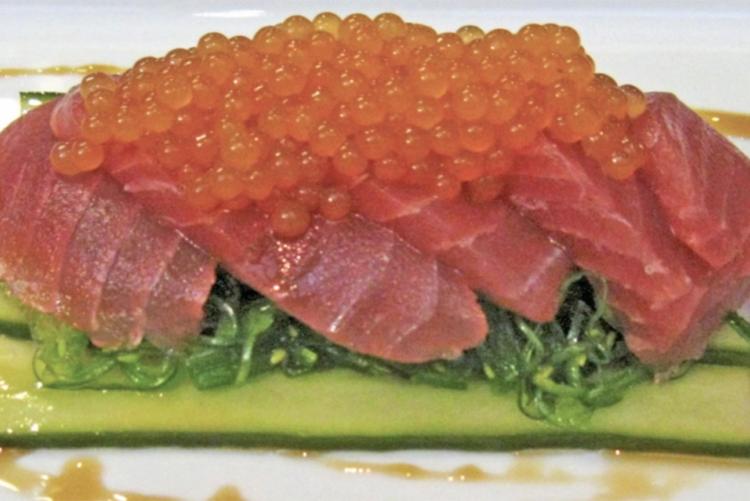
Description
Ionic spherification was first introduced by Ferran Adrià of El Bulli. They would serve a beautiful apple "caviar" in a caviar tin, which at that time was absolutely mind-blowing. Because the overall technique is fairly simply, "faux caviar" quickly became many-a-cook's first foray into hydrocolloids and modern cuisine (also commonly referred to as "molecular gastronomy"). Although this recipe is to demonstrate the cantaloupe "caviar" we make specifically for our ahi sashimi, the ratios and techniques are fairly universal.
Ingredients
Instructions
The first step in creating cantaloupe "caviar" is to peel, seed, and juice the cantaloupe. This technique will work with any type of juice that has the consistency of water and has a fairly neutral PH. While faux caviar can be made from acidic, slightly alkaline, or viscous liquids, those techniques are outside the scope of this recipe post.
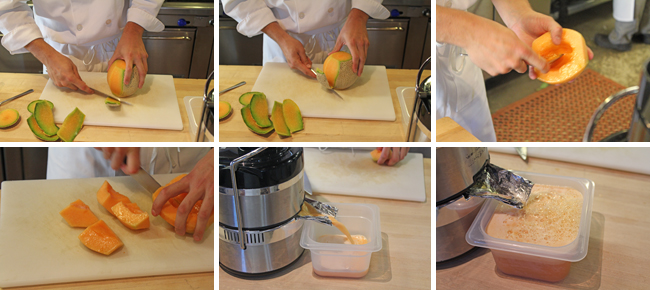
After juicing the cantaloupe, skim any froth that has formed on top of the juice and pass through a chinois to remove any particulate matter such as pulp and seeds.
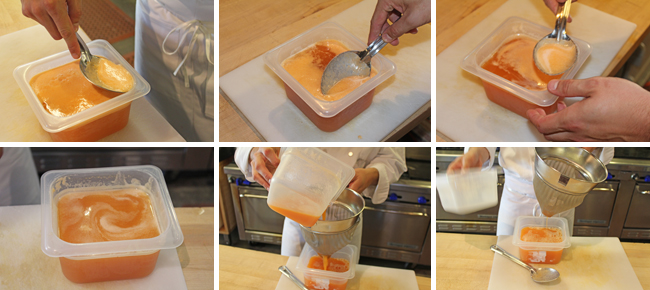
Next, weigh out your juice. For ease of calculation, I like to measure in grams. It's also easier to work in 100 gram increments unless you have a gram scale that is accurate to 1/10th of a gram. For example, if I have 320 grams of cantaloupe juice, I'll remove 20 grams. If I have 285 grams, I'll add 15 grams of water to get it up to an even 300g.
The reason why you want to work in increments of 100 is because the ratio of alginate will stay constant at 1% for pretty much any neutral PH juice. To find out how much alginate you'll need to add, simply multiply the total weight of your juice by 1%. The equation for this recipe would look like this: 300g (juice) x 1% (.01) = 3g Sodium Alginate.
Add the sodium alginate to the juice, spoon some juice over the top (the alginate will float), and allow it to hydrate for about two minutes. Blend with an immersion blender on high for 60-90 seconds, making sure that the alginate is thoroughly dispersed. Some people like to dissolve their alginate in a blender by blending their juice and slowly adding the alginate into the middle of the vortex created by the blender blade. While this does work better for dispersion, it also incorporates a lot of air into the liquid which will make it harder to form your "caviar" later. This can be avoided by sucking all the air out with a chamber vacuum sealer (if you have $4,000 burning a hole in your pocket), or by simply using an immersion blender.
After the alginate is incorporated into your "caviar" base, pass it through a chinois to insure a smooth texture and to remove any residual alginate that didn't disperse into your juice. Set aside for later use.
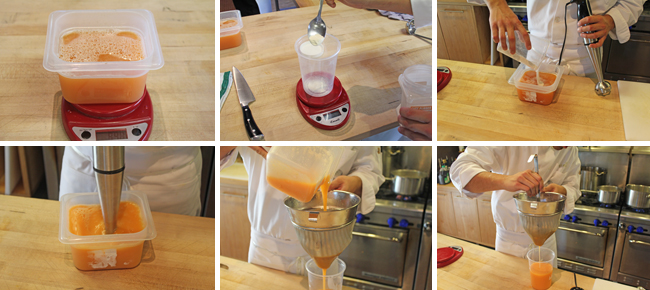
Next, you need to make your calcium bath. Here I'm using calcium chloride at the ratio of 1% by weight (pretty easy, huh?). Again, weigh out your cold water in increments of 100g just to make your calculations easier. Here, I'm using 500g of cold water so my calculation will look like this: 500g water x 1% (.01) = 5g.
The reason why I'm using 500 grams of water is because it makes a deep enough "bath" when placed in a 4" 6th pan (the plastic container shown in the picture below). You may need more water depending on the container your calcium chloride bath is in, but for a general rule of thumb, you'll want your bath to be at least 2" deep.
Mix the water bath with either a whisk or immersion blender for a couple of seconds. Calcium chloride is pretty water soluble and will dissolve if just left alone for about 5-10 minutes. Hitting the mix with a whisk or blender just speeds up the process.

Go grab your sodium alginate "caviar" base and give it one final skim. You'll notice that a little bit of scum has risen to the top (mainly due to the air bubbles incorporated in using the immersion blender). These air bubbles will cause your "caviar" to float on top of your calcium chloride bath, giving you gelled miniature pancakes instead of spheres.

Now that your calcium bath and alginate mixture are prepped, it's time to make some spheres. To make the "caviar" you'll need a plastic syringe that will allow you to drip little drops of your alginate mixture into your calcium bath. In the picture below, I'm using a special "caviar maker" which allows me to deliver multiple drops of "caviar" simultaneously, producing "caviar" quickly and in quantity. This is especially helpful when doing these in a restaurant environment because every serving of "caviar" needs to be made-to-order.
As shown in the picture below, drip the alginate mixture into the calcium bath. As soon as the alginate comes into contact with the calcium, each calcium ion will take the place of two sodium ions, (linking two alginate chains together) which in turn forms a gel (ionic spherification). This process of gelation will not stop until the piece of "caviar" has gelled all the way through, yielding a hard rubber pellet that would be more at home in a Red Ryder BB Gun then served as food. Alginate gels also have poor flavor retention, which means the more gelled the object is, the less flavor it will have.
This is why (as I mentioned above) each serving of "caviar" must be made-to-order and then served immediately. This way there will only be a thin layer of gel encapsulating a liquid center that will burst when bitten into (very much mimicking the chew and bite of real caviar). The thin layer of alginate gel is purely textural, whereas the liquid juice contained in the center is where all the flavor is.
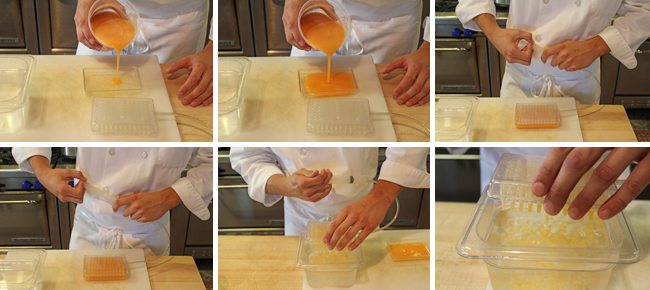
Allow the "caviar" to "cook" in the calcium bath for 30-60 seconds, after which you'll want to pass it through a strainer (reserving the calcium bath for later use) and then gently rinse the "caviar" under cold water. The purpose for the rinsing is that the chloride in the calcium is slightly bitter, but will only exist on the exterior of the "caviar" which is easily rinsed away.
Some people will use Calcium Lactate Gluconate which has no flavor and isn't bitter, but it's also much more expensive and needs to be used in greater proportion (usually 2.5-3% by weight). This is why I use calcium chloride for basic spherification such as fruit "caviar", and will save the Calcium Lactate Gluconate for reverse spherifcation (more on this in the notes section below).
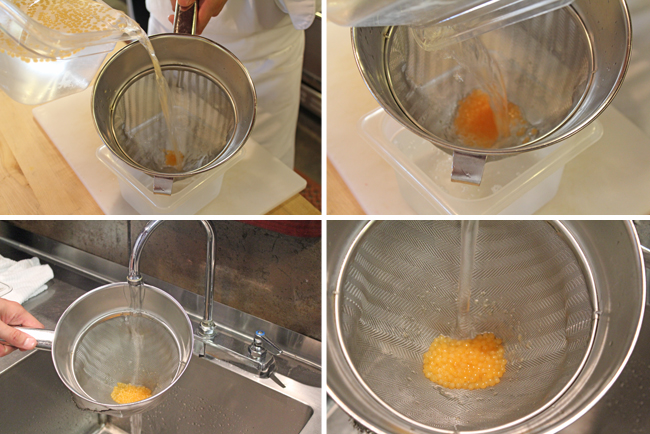
You can also use this same method but on a larger scale to form a yolk-like sphere as shown in the pictures below. This takes a little practice, and requires you to get the spoon right up next to the calcium bath. One thing to remember is that if the spoon touches the calcium bath, be sure to rinse and wipe clean before returning to your alginate mixture, it will (over time) thicken the alginate into a gel.
After dropping the large "sphere" into the calcium bath and allowing it to "cook" for about 60-90 seconds, remove it to a cold water bath to rinse any excess calcium chloride from the surface of the sphere. A nifty little slotted spoon helps a lot.
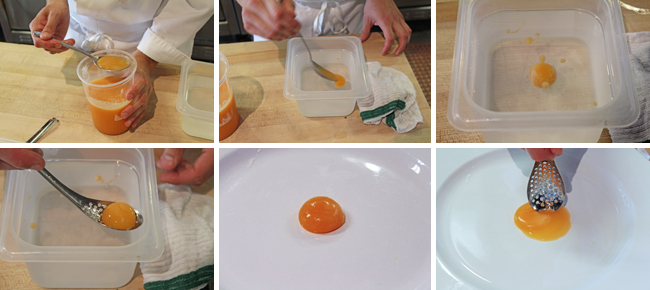
horizotal tabs
There are 4 Comments

Thanks Nina, I'm glad you
Thanks Nina, I'm glad you enjoyed the post.
